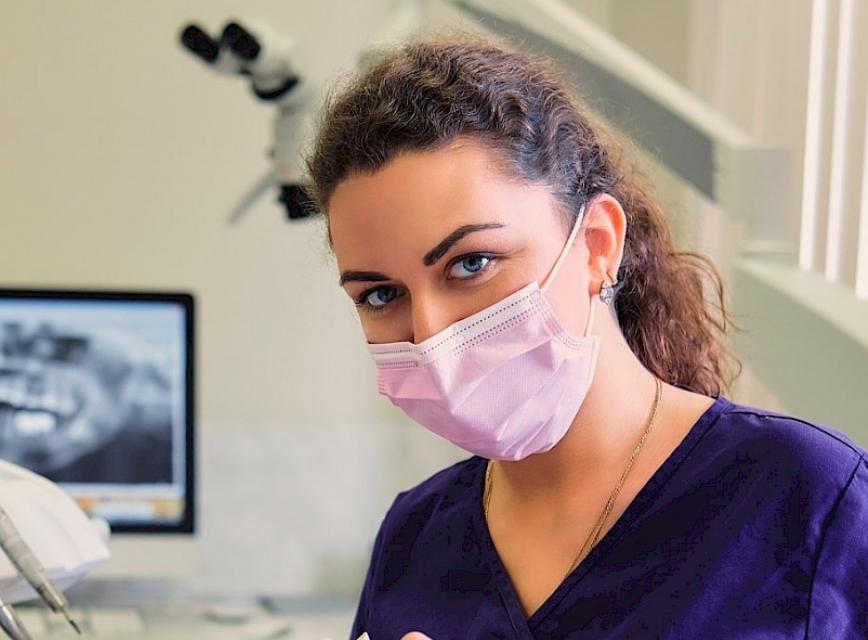What is surgical tooth extraction?
Tooth extraction is the process of removing the tooth from its socket called the socket in the bone.
When is it applied?
Teeth damaged due to caries or fractures are treated by the dentist with a filling, crown or other treatment method. However, sometimes the damage to the tooth becomes very large and the tooth becomes incurable. Therefore, the tooth must be extracted.
Other causes of tooth extraction:
In case of an extra tooth blocking the tooth coming from the bottom, to gain the necessary place for the proper placement of the teeth in people who will undergo orthodontic treatment. It is necessary for people who will undergo radiation therapy to the head and neck area to undergo oral and dental examinations before radiation therapy and to remove teeth that are at risk of infection in the mouth. Impacted teeth, especially the third molars, begin to erupt in the late teens or early twenties. These teeth are usually pulled out before or after driving. These teeth may need to be pulled out because they cause space congestion, caries or pain in the jaws.
Preparation
Your medical and dental history is learned by your dentist. An X-ray is taken to make the best plan necessary for tooth extraction. If all the buried teeth are to be removed, a panoramic X-ray can be taken, in which all the teeth are visible.
How is the application made?
There are two types of tooth extraction: Simple and Surgical Tooth Extraction Simple tooth extraction is the technique used to extract the teeth that appear in the mouth. It is performed under local anaesthesia. In simple tooth extraction, the tooth is held with the help of a tool. The tooth is loosened by making back-and-forth movements before extraction. This movement can sometimes be done with the help of a tool that goes between the tooth and Decubitus. Thus, the tooth is pulled out with minimal trauma. Surgical extraction is a technique used for extraction of teeth that are not easily visible in the mouth, are broken at the gingival border or have not erupted. In some cases, there may be bone on the tooth that needs to be removed. The tooth to be extracted may need to be removed after being divided into sections. In these cases, surgical extraction is also performed. The procedure can be performed with local anaesthesia, as with normal shooting. The gum must be opened to reach the tooth. The extraction of the upper buried teeth is usually easier than the lower ones. What Should be Done After Treatment There is mostly no discomfort after normal shooting. It may take several days of use of nonsteroidal anti-inflammatory drugs or the use of painkillers. Surgical procedures can cause pain because they are more complicated. Depending on the difficulty during the shooting, the symptoms and duration of the discomfort that will be experienced afterwards vary. A few days after the surgical removal, the pain disappears. Because the wound area dries up and a crust cannot form, wounds inside the mouth tend to bleed more than those on the skin. After the shooting, blood clotting is ensured by applying pressure to the area with gauze for at least 30 minutes. In the first 24 hours after, the area may continue to bleed in the form of leaks. The clot formed on the wound should not be disturbed. In order to prevent swelling after the operation, an ice compress should be applied to the operation area over the face. In the first few days after surgery, the swelling goes down. After the swelling has dissipated, if there is pain in your jaw and you feel tightness, you can make a warm compress. The first few days after the shooting, you should be fed with soft foods. Gargling with warm salt water (1/2 teaspoon of salt per glass of water) will also help keep the area clean for the first few days. Jul. It takes one to two weeks for the healing to be completed. If the area was closed with stitches after the shooting, these stitches should be removed one week after the procedure. After the operation, you should not spit, use a straw and do not smoke. These increase the bleeding and cause the blood clot formed after the operation to break down in the hole where the tooth was previously. So that 5% of all shots can cause dry bone inflammation called alveolitis. The occurrence of alveolitis is increasing in people who smoke, in women taking birth control pills, and after extractions of the teeth of the lower jaw.
What are the risks?
If you do not have a healthy immune system, there is a risk of developing an infection after tooth extraction. The most common complication is dry bone inflammation, which occurs when a blood clot does not form in the hole formed where the tooth was removed, or when the resulting blood clot breaks down. In dry bone inflammation, the underlying bone is exposed in such a way that it can come into contact with air and food debris. This is a condition that is very painful and can leave a bad taste and smell in the mouth. When dry bone inflammation occurs, the pain is stopped by dressing and the healing of the area is ensured.
What is a root resection?
As in the case of upper molars with three roots, the removal of a single root of teeth with an excessive number of roots is called root resection. In some cases, the crown supported by the root to be removed (the part of the tooth that can be seen in the mouth) may also need to be removed. Root canal treatment should be performed before the procedure. Root resections were performed more frequently in the past. However, nowadays it is recommended to remove the tooth and implant it instead. It is preferred to keep the natural tooth in the mouth instead of the implant. However, in some cases, an implant is a better solution.
In what cases is it applied?
Root resection is used to treat a problem (root caries, fracture, or bone loss around the root) of teeth with a large number of roots that are limited to a single root. Preparation: First of all, the tooth that needs root resection needs to undergo root canal treatment. Your dentist will examine your X-rays and perform an oral examination to determine if there is any caries or gum disease that needs to be treated before root resection. Local anaesthesia is applied for the procedure.
How is the application made?
In many cases, the necessary incisions are made to the gum so that the tooth roots can be exposed. The tooth is exposed, the roots are separated from the rest of the tooth. The root that has separated is pulled out. At the same time, parts of the teeth that are rotten or cannot be protected in the mouth are also removed by the dentist. After the procedure, the surgical area is washed with sterile serum. Stitches are used to close the incision area. The tooth is covered with a temporary filling or crown, and after a few months, it is replaced with a permanent restoration. Your dentist may prescribe painkillers, antimicrobial mouthwash with chlorhexidine, and antibiotics at the same time.
What needs to be done after treatment
In the first 24-48 hours, there may be swelling, slight bleeding and a feeling of discomfort. We recommend that you do not chew with that tooth until the stitches are removed. If swelling occurs, it reaches a maximum level in 48 hours and then decreases. You can apply ice to your face to reduce swelling. The stitches are removed within 7-10 days and the healing condition of the wounded area is checked by your dentist. When the wounded area is fully healed, the tooth retooling (filling or crown) is completed.
What is the flattening of the tubers?
Tubers are round-shaped bony protrusions located behind the last molar in the upper jaw. They are covered with gums.
In which cases is it applied?
If all your teeth are in your mouth, tubers are usually not a problem for you. However, if you lose your upper teeth and need a prosthesis, it may cause the mismatch of the prosthesis because the tubers will be sagging from other parts of your upper jaw. It prevents the sealing of a wide tuber prosthesis between the jawbone and the Decapitation of the mouth.
Preparation (preparation)
An X-ray is needed before treatment.
How is it applied?
First of all, local anaesthesia is applied. Excess gum tissue is removed by cutting. Then the bone located at the bottom is smoothed by shaving. After sufficient gingival and bone tissue has been removed, the suture is removed.
After treatment
Antibiotics and painkillers can be used after the procedure. We will tell you how to keep the operation area clean and how mouthwash should be used. If the stitches are not of the self-dissolving type, they should be removed after 7-10 days. Risks: As with all surgical procedures, there is a risk of bleeding and infection after this treatment.





